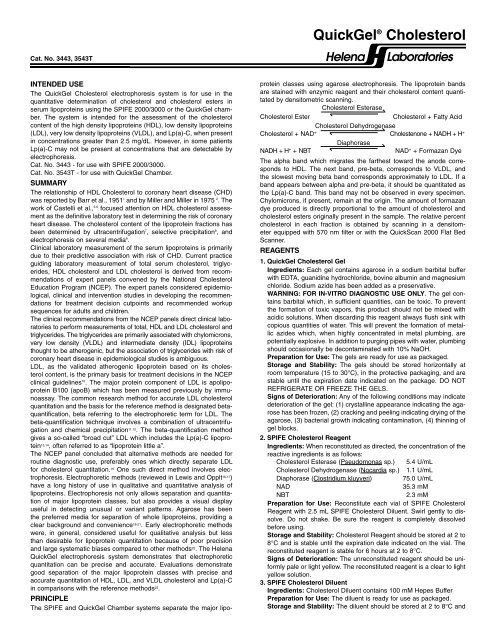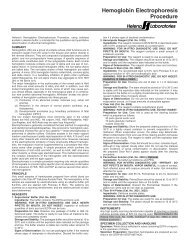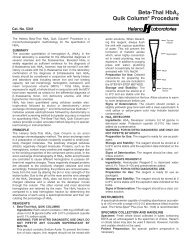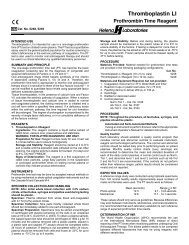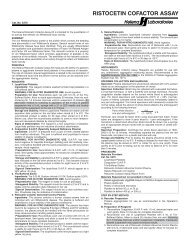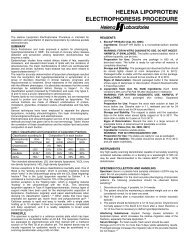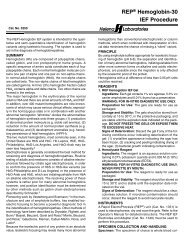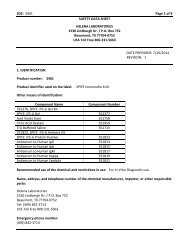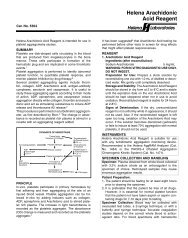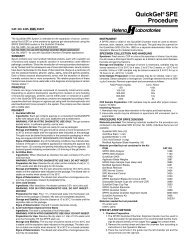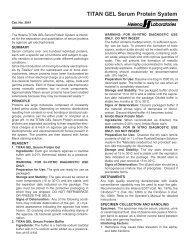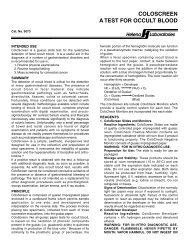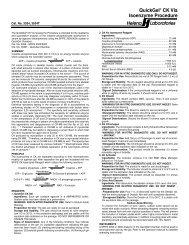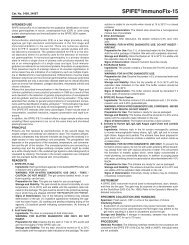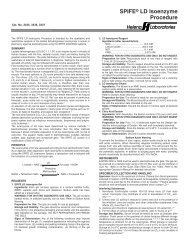QuickGel® Cholesterol - Helena
QuickGel® Cholesterol - Helena
QuickGel® Cholesterol - Helena
You also want an ePaper? Increase the reach of your titles
YUMPU automatically turns print PDFs into web optimized ePapers that Google loves.
QuickGel ® <strong>Cholesterol</strong>Cat. No. 3443, 3543T <strong>Helena</strong> LaboratoriesINTENDED USEThe QuickGel <strong>Cholesterol</strong> electrophoresis system is for use in thequantitative determination of cholesterol and cholesterol esters inserum lipoproteins using the SPIFE 2000/3000 or the QuickGel chamber.The system is intended for the assessment of the cholesterolcontent of the high density lipoproteins (HDL), low density lipoproteins(LDL), very low density lipoproteins (VLDL), and Lp(a)-C, when presentin concentrations greater than 2.5 mg/dL. However, in some patientsLp(a)-C may not be present at concentrations that are detectable byelectrophoresis.Cat. No. 3443 - for use with SPIFE 2000/3000.Cat. No. 3543T - for use with QuickGel Chamber.SUMMARYThe relationship of HDL <strong>Cholesterol</strong> to coronary heart disease (CHD)was reported by Barr et al., 1951 1 and by Miller and Miller in 1975 2 . Thework of Castelli et al., 3-6 focused attention on HDL cholesterol assessmentas the definitive laboratory test in determining the risk of coronaryheart disease. The cholesterol content of the lipoprotein fractions hasbeen determined by ultracentrifugation 7 , selective precipitation 8 , andelectrophoresis on several media 9 .Clinical laboratory measurement of the serum lipoproteins is primarilydue to their predictive association with risk of CHD. Current practiceguiding laboratory measurement of total serum cholesterol, triglycerides,HDL cholesterol and LDL cholesterol is derived from recommendationsof expert panels convened by the National <strong>Cholesterol</strong>Education Program (NCEP). The expert panels considered epidemiological,clinical and intervention studies in developing the recommendationsfor treatment decision cutpoints and recommended workupsequences for adults and children.The clinical recommendations from the NCEP panels direct clinical laboratoriesto perform measurements of total, HDL and LDL cholesterol andtriglycerides. The triglycerides are primarily associated with chylomicrons,very low density (VLDL) and intermediate density (IDL) lipoproteinsthought to be atherogenic, but the association of triglycerides with risk ofcoronary heart disease in epidemiological studies is ambiguous.LDL, as the validated atherogenic lipoprotein based on its cholesterolcontent, is the primary basis for treatment decisions in the NCEPclinical guidelines 10 . The major protein component of LDL is apolipoproteinB100 (apoB) which has been measured previously by immunoassay.The common research method for accurate LDL cholesterolquantitation and the basis for the reference method is designated betaquantification,beta referring to the electrophoretic term for LDL. Thebeta-quantification technique involves a combination of ultracentrifugationand chemical precipitation 11,12 . The beta-quantification methodgives a so-called “broad cut” LDL which includes the Lp(a)-C lipoprotein13,14 , often referred to as “lipoprotein little a”.The NCEP panel concluded that alternative methods are needed forroutine diagnostic use, preferably ones which directly separate LDLfor cholesterol quantitation. 15 One such direct method involves electrophoresis.Electrophoretic methods (reviewed in Lewis and Opplt 16,17 )have a long history of use in qualitative and quantitative analysis oflipoproteins. Electrophoresis not only allows separation and quantitationof major lipoprotein classes, but also provides a visual displayuseful in detecting unusual or variant patterns. Agarose has beenthe preferred media for separation of whole lipoproteins, providing aclear background and convenience 18-21 . Early electrophoretic methodswere, in general, considered useful for qualitative analysis but lessthan desirable for lipoprotein quantitation because of poor precisionand large systematic biases compared to other methods 22 . The <strong>Helena</strong>QuickGel electrophoresis system demonstrates that electrophoreticquantitation can be precise and accurate. Evaluations demonstrategood separation of the major lipoprotein classes with precise andaccurate quantitation of HDL, LDL, and VLDL cholesterol and Lp(a)-Cin comparisons with the reference methods 23 .PRINCIPLEThe SPIFE and QuickGel Chamber systems separate the major lipoproteinclasses using agarose electrophoresis. The lipoprotein bandsare stained with enzymic reagent and their cholesterol content quantitatedby densitometric scanning.<strong>Cholesterol</strong> Esterase<strong>Cholesterol</strong> Ester<strong>Cholesterol</strong> + Fatty Acid<strong>Cholesterol</strong> Dehydrogenase<strong>Cholesterol</strong> + NAD + Cholestenone + NADH + H +DiaphoraseNADH + H + + NBTNAD + + Formazan DyeThe alpha band which migrates the farthest toward the anode correspondsto HDL. The next band, pre-beta, corresponds to VLDL, andthe slowest moving beta band corresponds approximately to LDL. If aband appears between alpha and pre-beta, it should be quantitated asthe Lp(a)-C band. This band may not be observed in every specimen.Chylomicrons, if present, remain at the origin. The amount of formazandye produced is directly proportional to the amount of cholesterol andcholesterol esters originally present in the sample. The relative percentcholesterol in each fraction is obtained by scanning in a densitometerequipped with 570 nm filter or with the QuickScan 2000 Flat BedScanner.REAGENTS1. QuickGel <strong>Cholesterol</strong> GelIngredients: Each gel contains agarose in a sodium barbital bufferwith EDTA, guanidine hydrochloride, bovine albumin and magnesiumchloride. Sodium azide has been added as a preservative.WARNING: FOR IN-VITRO DIAGNOSTIC USE ONLY. The gel containsbarbital which, in sufficient quantities, can be toxic. To preventthe formation of toxic vapors, this product should not be mixed withacidic solutions. When discarding this reagent always flush sink withcopious quantities of water. This will prevent the formation of metallicazides which, when highly concentrated in metal plumbing, arepotentially explosive. In addition to purging pipes with water, plumbingshould occasionally be decontaminated with 10% NaOH.Preparation for Use: The gels are ready for use as packaged.Storage and Stability: The gels should be stored horizontally atroom temperature (15 to 30°C), in the protective packaging, and arestable until the expiration date indicated on the package. DO NOTREFRIGERATE OR FREEZE THE GELS.Signs of Deterioration: Any of the following conditions may indicatedeterioration of the gel: (1) crystalline appearance indicating the agarosehas been frozen, (2) cracking and peeling indicating drying of theagarose, (3) bacterial growth indicating contamination, (4) thinning ofgel blocks.2. SPIFE <strong>Cholesterol</strong> ReagentIngredients: When reconstituted as directed, the concentration of thereactive ingredients is as follows:<strong>Cholesterol</strong> Esterase (Pseudomonas sp.) 5.4 U/mL<strong>Cholesterol</strong> Dehydrogenase (Nocardia sp.) 1.1 U/mLDiaphorase (Clostridium kluyveri) 75.0 U/mLNAD35.3 mMNBT2.3 mMPreparation for Use: Reconstitute each vial of SPIFE <strong>Cholesterol</strong>Reagent with 2.5 mL SPIFE <strong>Cholesterol</strong> Diluent. Swirl gently to dissolve.Do not shake. Be sure the reagent is completely dissolvedbefore using.Storage and Stability: <strong>Cholesterol</strong> Reagent should be stored at 2 to8°C and is stable until the expiration date indicated on the vial. Thereconstituted reagent is stable for 6 hours at 2 to 8°C.Signs of Deterioration: The unreconstituted reagent should be uniformlypale or light yellow. The reconstituted reagent is a clear to lightyellow solution.3. SPIFE <strong>Cholesterol</strong> DiluentIngredients: <strong>Cholesterol</strong> Diluent contains 100 mM Hepes BufferPreparation for Use: The diluent is ready for use as packaged.Storage and Stability: The diluent should be stored at 2 to 8°C and
is stable until the expiration date indicated on the vial.Signs of Deterioration: Discard the diluent if it shows signs ofbacterial growth.4. Citric Acid DestainIngredients: After dissolution, the destain contains 0.3% (w/v) citricacid.WARNING: FOR IN-VITRO DIAGNOSTIC USE ONLY. - IRRITANT- DO NOT INGEST.Preparation for Use: Pour 11 L of deionized water into the Destainvat. Add the entire package of Destain. Mix well until completelydissolved.Storage and Stability: Store the Destain at 15 to 30°C. It is stableuntil the expiration date on the package.Signs of Deterioration: Discard if solution becomes cloudy.INSTRUMENTSA SPIFE 2000/3000 or the QuickGel Chamber must be used to electrophoresethe gel. The gel can be scanned on a densitometer suchas the QuickScan 2000 (Cat. No. 1660). Refer to the appropriateOperator’s Manual for detailed operating instructions.SPECIMEN COLLECTION AND HANDLINGSpecimen: Serum samples are the specimen of choice.Patient Preparation: The cholesterol content of the alpha (HDL) andbeta (LDL) and Lp(a)-C lipoproteins is not materially affected by recentmeals. 3 Therefore, if the HDL cholesterol is the only parameter of interest,the patient need not be fasting.Interfering Substances:1. Heparin administered I.V. causes activation of lipoprotein lipase,which tends to increase the relative migration rate of the fractions,especially the Beta lipoprotein 24 .2. For effects of various drugs, refer to Young et al 25 .Specimen Storage: For best separation of the various lipoproteins,fresh serum should be used. If testing cannot be performed immediately,the sample should be stored at 2 to 8°C no longer than 4 days.The specimen should never be stored frozen. Freezing may irreversiblyalter the lipoprotein separation 26 . No additives or preservativesare necessary.PROCEDURE for spife 2000/3000Materials Provided: The following materials are provided in theQuickGel <strong>Cholesterol</strong> Kit for SPIFE (Cat. No. 3443). Individual itemsare not available.QuickGel <strong>Cholesterol</strong> Gels (10)SPIFE <strong>Cholesterol</strong> Reagent (10 x 2.5 mL)SPIFE <strong>Cholesterol</strong> Diluent (1 x 25 mL)Citric Acid Destain (1 pkg)QuickGel Blotter C (10)QuickGel Blotter X (20)Applicator Blade Assembly - 20 Samples (10)Materials provided by <strong>Helena</strong> but not contained in the kit:Cat. No.SPIFE 3000 1088SPIFE 2000 1130QuickScan 2000 1660<strong>Cholesterol</strong> Profile Control 3218REP Prep 3100Gel Block Remover 1115SPIFE Disposable Cups (Deep Well) 3360QuickGel Dispo Cup Tray 3353SPIFE QuickGel Electrodes 1111SPIFE QuickGel Gel Holder 3358QuickGel Chamber Alignment Guide 86541003SPIFE 3000/Rep 3 Reagent Spreaders 3706SPIFE QuickGel Disposable Stainless Steel Electrodes 3357SPIFE Reagent Spreaders 3386step by step methodI. Chamber Preparation1. The SPIFE QuickGel Chamber Alignment Guide must be used tomark the location for gel placement if the chamber floor has notbeen marked previously. It is recommended that the markings beplaced directly on the copper floor under the contact sheet.2. Remove the contact sheet & clean the chamber floor according toinstructions in the Operator’s Manual.3. Place the round hole in the guide over the left chamber pin and theobround hole over the right pin.4. Using an indelible marker, outline the rectangular open area ontothe copper floor. Allow marking to dry, and apply another contactsheet.II. Stainer PreparationNOTE: If a SPIFE procedure requiring a stain has been run priorto running the cholesterol gels, the stainer unit must be cleaned/washed before washing the cholesterol gel.SPIFE 3000The SPIFE has an automatic wash cycle prompted by initiationof a test which does not use the stainer unit for staining whenthe previous test did use the stainer for staining. To avoid delaysafter electrophoresis, this wash cycle should be initiated at leastseven (7) minutes prior to the end of the run. To verify the status,press the TEST SELECT/CONTINUE button on the staineruntil the appropriate test is selected. Place an empty Gel Holderin the stainer unit. If cleaning is required, the “Wash 1” promptwill appear, followed by “Plate out, Holder in” prompts. Press“Continue” to begin the stainer wash. The cleaning process willcomplete automatically in about 7 minutes. The unit is then readyto process the gel after electrophoresis.SPIFE 2000If utilizing the unit for both stained and non-stained gels, log usageto determine when cleaning is necessary. Create a program toclean the unit as a “User Test” according to the following:User Test1) No PromptWash 1 1:00 REC=ON VALVE=72) No PromptWash 2 1:00 REC=ON VALVE=73) No PromptWash 3 1:00 REC=ON VALVE=74) No PromptWash 4 1:00 REC=ON VALVE=75) No PromptEND OF TESTIII. Preparation of Reagent1. Reconstitute the SPIFE <strong>Cholesterol</strong> Reagent with 2.5 mL SPIFE<strong>Cholesterol</strong> Diluent. Mix well by inversion.IV. Sample Preparation1. Remove one disposable Applicator Blade Assembly from thepackaging. Remove the protective guards from the blade bygently bending the protective piece back and forth until it breaksfree.2. Place the Applicator Blade into the vertical slot numbered 6 in theApplicator Assembly.Please note that the blade assembly will only fit into theslots one way; do not try to force the blade assembly into theslots.3. Slide a strip of Disposable Cups into top row numbered 1 to 10of the appropriate Cup Tray.4. Pipette 75 to 80 µL of patient serum or control into cups numbered1 to 5 and 6 to 10. Cover the samples until ready to use.V. Gel Preparation1. Carefully cut open the end of the gel pouch. Remove one gelfrom the protective packaging. Fold and tape the open end ofthe pouch to prevent drying of the gel. Remove the gel from theplastic mold and discard the mold.2. Using a QuickGel Blotter C, gently blot the entire gel using slightfingertip pressure on the blotter. Remove the blotter.3. Dispense approximately 1 mL of REP Prep onto the left side ofthe rectangle on the electrophoresis chamber floor.4. Place the edge of the gel next to the left edge of the marked rectangle.Gently lay the gel down on the REP Prep, starting fromthe left side and ending on the right side. Make sure no bubblesremain under the gel.5. Use lint-free tissue to wipe around the edges of the plastic gelbacking to remove excess REP Prep.6. Thoroughly wash electrodes with deionized water before andafter each use. Wipe the QuickGel Electrode with a lint-free tissue.The Stainless Steel Electrode must be patted dry becauseof the rough surface. Ensure that the endcaps are screwed ontightly. The Stainless Steel Electrode must be replaced after use
on 50 gels. Unscrew the endcaps from the old electrode andscrew them tightly onto the new electrode.7. Place a QuickGel Electrode on the outside ledge of the left gelblock (cathode end) inside the magnetic posts.8. Place a QuickGel Stainless Steel Electrode on the outside ledgeof the right gel block (anode end) of the gel inside the magneticposts. Close the chamber lid.9. Press the TEST SELECT/CONTINUE button located on theElectrophoresis and Stainer sides of the instrument until theappropriate test name appears on the display.VI. Sample Application/ElectrophoresisUsing the instructions provided in the Operator’s Manual, set up theparameters as follows for the SPIFE 3000 or the SPIFE 2000.A. SPIFE 3000Electrophoresis Unit1) No PromptLoad Sample 1 00:30 20°C SPD62) No PromptApply Sample 1 1:00 20°C SPD6 LOC13) To Continue, (continue)Electrophoresis 1 25:00 16°C 220 V 60 mA4) Remove blotter, (continue)Apply Reagent 1 30°C 8 cycles5) No PromptIncubate 1 15:00 30°C6) No promptEnd of testStainer Unit1) No PromptWash 1 5:00 REC = REV VALVE = 22) No PromptWash 2 5:00 REC = REV VALVE = 73) No PromptDry 1 15:00 70°C4) No PromptEND OF TEST1. Place the Cup Tray with samples on the SPIFE 3000. Alignthe holes in the tray with the pins on the instrument.2. Place a reconstituted vial of reagent in the center hole of thereagent bar, ensuring that the vial is pushed down as far as itcan go. Close the chamber lid.3. With QG-CHOLESTEROL on the display, press the START/STOP button. An option to either begin the test or skip theoperation will be presented. Press START/STOP to begin.The SPIFE 3000 will apply the samples and beep.4. Remove the two QuickGel Blotter X’s from the package. Slidethe blotters under the ends of the carbon electrodes, directlyabove and below the cathode end of the gel, so that theytouch the gel block ends.5. Close the chamber lid and press CONTINUE. The SPIFE willelectrophorese and beep when completed.6. Open the chamber lid, remove electrodes and dispose ofBlotter X’s. Dispose of blades as biohazardous waste. Usinga Gel Block Remover, completely remove and discard the gelblocks on each end of the gel.7. Wipe the excess buffer and moisture from around the gel andchamber floor using a lint-free tissue.8. Place a SPIFE 3000 Reagent Spreader (glass rod) inside themagnetic posts at each end of the chamber.9. Close the chamber lid and press the TEST SELECT/CONTINUE button to pour, spread reagent and start the incubationtimer.10. At the end of the incubation, remove the glass rods and thegel from the chamber. Proceed to Step V.B. SPIFE 2000Electrophoresis Unit1) No PromptLoad Sample 1 00:30 20° SPD.=62) No PromptApply Sample 1 1:00 20°C SPD.=63) To Continue, (continue)Electrophoresis 1 25:00 16°C 220 VOLTS4) Apply/Spread Reagent, (continue)Incubate 1 15:00 30°C5) No promptEnd of testStainer Unit1) No PromptWash 5:00 cir = ON VALVE = 22) No PromptWash 2 5:00 cir = ON VALVE = 73) No PromptDry 1 20:00 70°C4) No PromptEND OF TEST1. Place the Cup Tray with samples on the SPIFE 2000. Alignthe holes in the tray with the pins on the instrument. Close thechamber lid.2. With CHOLESTEROL on the display, press the START/STOPbutton. An option to either begin the test or skip the operationwill be presented. Press START/STOP to begin. The SPIFE2000 will apply the samples, and beep when completed.Dispose of blades as biohazardous waste.3. Remove the two QuickGel Blotter X’s from the package. Slidethe blotters under the ends of the carbon electrodes, directlyabove and below the cathode end of the gel, so that they touchthe gel block ends.4. Close the chamber lid and press CONTINUE. The SPIFE willelectrophorese and beep when completed.5. Open the chamber lid, remove electrodes and dispose ofBlotter X’s. Using a Gel Block Remover, completely removeand discard the gel blocks on each end of the gel.6. Wipe the excess buffer and moisture from around the gel andchamber floor using a lint-free tissue.7. Pour the contents of the SPIFE <strong>Cholesterol</strong> Reagent vialacross the cathode end of the gel. Use the Reagent Spreaderto work the reagent into the gel. Set the ends of the ReagentSpreader on the inner ledge of the electrophoresis chamberwith the rod laying on the gel.8. Slowly slide the spreader across the gel. Tilt the spreader towardthe gel block area so the reagent relocates along the rod.9. Repeat this until the reagent has been spread eight times ineach direction. On the last spread across the gel, continueto drag the rod off the end of the gel to dispose of excessreagent.10. Close the chamber lid. Press the TEST SELECT/CONTINUEbutton to start the incubation timer.11. After incubation, carefully remove the gel from the electrophoresischamber.V. Washing1. Remove the SPIFE QuickGel Holder from the stainer chamber.While holding the gel agarose side down, slide one side of the gelbacking under one of the metal bars. Bend the gel backing so thatthe gel is bowed, and slip the other side under the other metal bar.The two small notches in the backing must fit over the small pinsto secure the gel to the holder.2. Place the SPIFE QuickGel Holder with the attached gel facingbackwards into the stainer chamber.3. With the appropriate test name on the display, press the START/STOP button. An option to either begin the test or skip the operationwill be presented. Press START/STOP to begin. The instrumentwill wash and dry the gel.4. When the gel has completed the process, the instrument will beep.Remove the Gel Holder from the stainer and you can scan thebands.PROCEDURE FOR QuickGel ® CHAMBERThe following instructions are for using the QuickGel Chamber (Cat. No.1284) for electrophoresis.Materials Provided: The following materials needed for the procedureare contained in the QuickGel <strong>Cholesterol</strong> Kit (Cat. No. 3543T).Individual items are not available.QuickGel <strong>Cholesterol</strong> Gels (10)SPIFE <strong>Cholesterol</strong> Reagent (10 x 2.5 mL)SPIFE <strong>Cholesterol</strong> Diluent (1 x 25 mL)
QuickGel Blotter C (10)Citric Acid Destain (1 pkg)QuickGel Templates (10)QuickGel Blotter A (10)QuickGel Blotter X (20)Materials provided but not contained in the kit:ItemCat. No.QuickScan 2000 1660QuickGel Chamber 1284Titan Blotter Pads 5037Staining Dish 4061Incubation Chamber 4062REP Prep 3100QuickGel Gel Block Remover 1262<strong>Cholesterol</strong> Profile Control 3218Materials needed but not provided:5 mL serological pipettePower Supply capable of providing at least 220 Volts.Incubator capable of maintaining 30°CStep by Step MethodI. Chamber Preparation1. The QuickGel Chamber must be plugged into a power supply.Set a timer for *23:00 minutes and the power at 220 Volts. *Anelectrophoresis time of 22:30 to 23:30 minutes is acceptable.2. Snap the Electrophoresis Lid into place on the chamber.3. Ensure that the chamber floor is cool (room temperature) beforestarting the test.II. Preparation of the Incubation Chamber1. Place a Titan Blotter Pad in the bottom of the incubationchamber.2. Wet the blotter completely with water and then pour offexcess.3. Close the chamber and place it in a laboratory incubator at30°C.4. Allow the blotter to equilibrate to 30°C while performing theelectrophoresis steps.III. Preparation of Reagent1. Reconstitute the SPIFE <strong>Cholesterol</strong> Reagent with 2.5 mL SPIFE<strong>Cholesterol</strong> Diluent. Mix well by inversion.IV. Sample Template Application1. Carefully cut open one end of the gel pouch. Remove one gelfrom the protective packaging. Fold and tape the open end ofthe pouch to prevent drying of the remaining gel. Remove thegel to be used from the plastic mold and discard the mold.2. Dispense approximately 1 mL of REP Prep onto the left side ofthe electrophoresis chamber.3. Place the left notch of the gel so that it fits the left pin of thechamber floor and gently roll the gel to the right side fitting theright notch to the right pin of the chamber floor. Use a lint freetissue to wipe around the edges of the gel backing to removeany excess REP Prep. Make sure that no bubbles remainunder the gel.4. Using a QuickGel Blotter C, gently blot the entire gel using slightfingertip pressure on the blotter. Remove the blotter.5. Remove one QuickGel Template from the package. Hold thetemplate so that the small hole in the corner is toward the frontright side of the chamber.6. Carefully place the template on the gel aligning the templateslits with the marks on each side of the gel backing. The centerhole in the template should align with the indention in the centerof the gel.7. Apply slight fingertip pressure to the template making sure thereare no bubbles under it. NOTE: If wearing rubber gloves toperform this step, place a QuickGel Blotter A over the templateand then apply fingertip pressure to the template. Remove theblotter. Powder from the gloves can produce gel artifacts.8. Apply 3 µL of the appropriate sample to the template slits. Afterthe last sample application, wait 5 minutes to allow time for theproper absorption.9. Use the QuickGel Blotter A to gently blot the excess samplefrom the template. Carefully remove the template.10. Place two Blotter X's horizontally along the top and bottom sidesof the gel backing. They should be positioned along the edges(not touching the gel) so that, when the lid closes, the BlotterX's do not interfere with the electrodes.11. Close the lid, press the power switch to turn on the chamberand start the power supply.V. Electrophoresis and Incubation1. Electrophorese the gel for *23:00 minutes at 220 Volts.2. Turn off the power supply and the QuickGel Chamber.3. Open the lid and remove the blotters.4. Using the QuickGel Gel Block Remover, remove the two gelblocks from the gel. Again, use a lint free tissue to wipe aroundthe edges of the gel backing to remove any excess moisture.5. Remove the gel from the chamber and place it, agarose sideup, on a clean nonporous surface with the cathode edge (top ofgel) away from you.6. Pour the contents of the vial of reagent along the cathode edgeof the gel.7. Lay a 5 mL serological pipette lengthwise along the cathodeedge of the gel. Gently spread the reagent by slowly pulling thepipette across the agarose to the anode edge, being careful notto roll the reagent off the gel. Wait for 15 seconds. Then pull thepipette across the gel from anode to the cathode edge in thesame manner. Wait 15 seconds. Then pull the pipette acrossthe gel from cathode to anode and roll the excess off the gel.8. Place the gel into the preheated (30°C) Incubation Chamber.9. Place the Incubation Chamber in a laboratory incubator at 30°Cfor 15 minutes.10. Two containers are needed: one for the Destain solution andone for the deionized water wash. The size of the containershould be able to accommodate a gel laid flat. Pour a sufficientamount of Destain into one container to cover the gel. Pour thesame amount of deionized water into the other container.11. At the end of incubation, remove the gel from the incubator.Place the gel in the destain solution using a gentle alternatelyrocking and swirling technique. Allow the gel to remain in thedestain solution for 5 minutes. Remove the gel and tap it toremove excess destain.12. Place the gel in the container of deionized water for 5 minutes.Use the same technique as in Step 11. Tap the gel to removethe excess water.13. Ensure the chamber floor is clean, and place the Drying Lid onthe chamber. Replace the gel onto the chamber floor. Closethe Drying Lid and turn on the chamber. Dry the gel for 20minutes or until dry. Remove the gel when drying is completed,and turn off the chamber.Evaluation of FractionsFor quantitation of the lipoprotein cholesterol fractions scan the gel,agarose side up, in the Quick Scan 2000.Stability of End Product: For best results, scan the QuickGel<strong>Cholesterol</strong> Gel within 5 minutes.Calibration: A calibration curve is not necessary as relative density ofthe fractions is the only parameter determined.Quality Control: Quantitation of HDL <strong>Cholesterol</strong> values should bemonitored using the <strong>Cholesterol</strong> Profile Control (Cat. No. 3218). Thiscontrol verifies all phases of the procedure and should be used oneach gel run. Refer to the package insert provided with the control fordetailed information and assay values.REFERENCE VALUESLipoprotein cholesterol values vary according to age and sex 26 , andwide variations among different geographical locations and races havebeen reported 6. . Therefore, it is essential that each laboratory establishits own expected range for its particular population.A total of 54 patients with normal total cholesterol (total cholesterol≤ 200 mg/dL) were tested using the QuickGel <strong>Cholesterol</strong> system.These patients have not been differentiated by age, race or sex. Thesevalues should only serve as guidelines.Range (x¯ ± 2 SD)HDL (%) 11.8 - 45.0Lp(a)-C% 0.0 - 12.2VLDL (%) 0.0 - 20.3LDL (%) 47.6 - 77.5Each laboratory should establish its own range for age, sex and race.
RESULTSThe QuickGel <strong>Cholesterol</strong> system separates the major lipoproteinclasses. The alpha band which migrates the farthest toward the anodecorresponds to HDL. The next band, pre-beta, corresponds to VLDL.If a band appears between alpha and pre-beta, it is the Lp(a)-C bandand should be added to the LDL quantitation when reporting the totalLDL value. 27 It does not appear in every sample at measurable concentrations.The slowest moving beta band corresponds approximately toLDL. Chylomicrons, if present, remain at the origin.Calculations<strong>Helena</strong> densitometers will automatically calculate and print the relativepercent and the absolute values for each band when the specimentotal cholesterol is entered. Refer to the Operator’s Manual providedwith the instrument.HDL Lp(a)-C VLDL LDLFigure 1: A scan of a QuickGel <strong>Cholesterol</strong> pattern.LIMITATIONSThis method is intended for the separation and quantitation of lipoproteinclasses. Refer to the SPECIMEN COLLECTION AND HANDLINGsection of this procedure for interfering factors.The system is linear to 400 mg/dL total cholesterol, with sensitivityto 2.5 mg/dL per band. Patient sample quantitations which exceedthe linearity of the system should be diluted with deionized water andretested.Lp(a)-C below the threshold level of 2.5 mg/dL may not be seen usingthis method, even if Lp(a)-C is present in the sample. To quantitatepatients who have an Lp(a)-C below 2.5 mg/dL, it is recommended thatan alternative method be used.INTERPRETATION OF RESULTSTreatment decisions in the NCEP guidelines are based primarily onLDL cholesterol levels 10 . The risk factors considered in the classificationscheme are age (males equal to or older than 45 years andfemales equal to or older than 55), family history of premature CHD,smoking, hypertension, and diabetes. Treatment is appropriate whenLDL cholesterol is at or above the following cut points: all patients ator above 160 mg/dL, with two or more risk factors a value above 130mg/dL and with symptoms of CHD a value above 100 mg/dL.HDL cholesterol is considered high risk at or below 35 mg/dL andcounted as one of the risk factors in the classification scheme. AnHDL cholesterol value above 60 mg/dL is considered protective andsubtracts one from the total number of risk factors.Treatment Decision Cut-Points 10Total <strong>Cholesterol</strong>Desirable Blood <strong>Cholesterol</strong>Borderline-High Blood <strong>Cholesterol</strong>High Blood <strong>Cholesterol</strong>HDL-<strong>Cholesterol</strong>Low HDL <strong>Cholesterol</strong>Protective HDL-<strong>Cholesterol</strong>TriglyceridesDesirableBorderlineElevatedVery Elevated< 200 mg/dL200-239 mg/dL≥ 240 mg/dL< 40 mg/dL≥ 60 mg/dL< 150 mg/dL150-199 mg/dL200-499 mg/dL≥ 500 mg/dLLDL-<strong>Cholesterol</strong>Dietary TherapyInitiation Level LDL GoalWithout CHD and fewerthan 2 risk factors ≥ 160 mg/dL < 160mg/dLWithout CHD and with2 or more risk factors ≥ 130 mg/dL < 130mg/dLWith CHD > 100 mg/dL ≤ 100mg/dLLDL-<strong>Cholesterol</strong>Drug TreatmentInitiation Level LDL GoalWithout CHD and fewerthan 2 risk factors ≥ 190 mg/dL < 160 mg/dLWithout CHD and with2 or more risk factors ≥ 160 mg/dL < 130 mg/dLWith CHD ≥ 130 mg/dL < 100 mg/dLPERFORMANCE CHARACTERISTICSPRECISIONPrecision studies were done using a control and a normal patient specimenon both the SPIFE and the QuickGel Chamber methods.SPIFEWithin Run - A single patient sample and a control were run in replicateon one gel. N = 5ControlHDL % Lp(a)-C VLDL % LDL %Mean 22.8 2.3 11.3 63.6SD 0.8 0.1 0.5 0.6CV 3.5% 3.7% 4.5% 0.9%Patient HDL % Lp(a)-C LDL %Mean 27.2 7.7 65.0SD 0.6 0.2 0.4CV 2.2% 3.1% 0.7%Between Run - A patient sample and a control were run in replicateon 9 gels. N = 45ControlHDL % Lp(a)-C VLDL % LDL %Mean 22.9 2.4 11.6 63.2SD 0.8 0.2 1.0 1.4CV 3.6% 7.3% 8.7% 2.3%Patient HDL % Lp(a)-C LDL %Mean 27.3 7.5 65.2SD 0.8 0.4 0.7CV 2.9% 5.7% 1.1%QuickGel ChamberWithin Run - A single patient sample and a control were run in replicateon one gel. N = 5ControlHDL % Lp(a)-C VLDL % LDL %Mean 23.9 2.4 10.5 63.3SD 0.7 0.2 0.3 0.7CV 3.1% 6.4% 3.1% 1.1%Patient HDL % Lp(a)-C LDL %Mean 29.5 6.9 63.6SD 0.8 0.1 0.8CV 2.7% 0.8% 1.3%Between Run - A patient sample and a control were run in replicateeach on 9 gels. N = 45ControlHDL % Lp(a)-C VLDL % LDL %Mean 23.4 2.4 10.5 63.7SD 0.9 0.2 0.3 1.0CV 3.8% 9.4% 3.2% 1.6%Patient HDL % Lp(a)-C LDL %Mean 29.4 6.8 63.8SD 1.5 0.5 1.5CV 5.3% 6.8% 2.3%
LINEARITY AND SENSITIVITYSerial dilutions of an elevated cholesterol sample were made andtested by this system. The linearity study showed that the system islinear to 400 mg/dL total cholesterol and that the system is sensitive to2.5 mg/dL per band.CORRELATION STUDIESA total of 81 patient samples, were run using SPIFE Vis <strong>Cholesterol</strong> asthe reference method. The following is the correlation data produced.N = 81SPIFEQuickGel ChamberR = 0.998 R = 0.998Y = 1.024X - 0.753 Y = 1.010X - 0.322X = SPIFE Vis <strong>Cholesterol</strong>X = SPIFE Vis <strong>Cholesterol</strong>Y = QuickGel <strong>Cholesterol</strong> on SPIFE Y = QuickGel <strong>Cholesterol</strong> onQuickGel ChamberBIBLIOGRAPHY1. Barr, D.P. et al., Protein-lipid Relationships in Human Plasma, Am J Med,11:480-493, 1951.2. Miller, G.J. and Miller, N.E., Plasma-High Density-Lipoprotein Concentration andDevelopment of Ischemic Heart Disease, Lancet, 1:16-19, 1976.3. Kannel, W.B. et al., Serum <strong>Cholesterol</strong>, Lipoproteins, and the Risk of Coronary HeartDisease, Ann Inter Med, 74(1):1-12, 1971.4. Gordon, T. et al., High Density Lipoprotein As a Protective Factor Against CoronaryHeart Disease. The Framingham Study. Am J Med 62:707-714, 1977.5. Galen, R.S., HDL <strong>Cholesterol</strong>, How Good a Risk Factor, Diag Med, 39-58, Nov/Dec.1979.6. Castelli, W.P. et al., HDL <strong>Cholesterol</strong> and Other Lipids in Coronary Heart Disease - TheCooperative Lipoprotein Phenotyping Study. Circulation, 55(5):767-772, 1977.7. Delalla, O.F. and Gofman, J.W., Ultracentrifugal Analysis of Serum Lipoprotein, inMethods of Biochemical Analysis, Vol. 1, Edited by D. Glick, New York, Interscience,459-478, 1954.8. Burstein, M. and Scholnick, H.R., Precipitation of chylomicrons and very low densitylipoproteins from human serum with sodium lauryl sulfate. Life Sci 11:177-184, 1972.9. Cobb, S.A. and Sanders, J.L. Enzymic Determination of <strong>Cholesterol</strong> in SerumLipoproteins Separated by Electrophoresis, Clin Chem 24(7):1116-1120, 1978.10. National <strong>Cholesterol</strong> Education Program, Third report of the expert panel on detection,evaluation and treatment of high blood cholesterol in adults (Adult Treatment Panel III).JAMA 285(19): 2486-2497, 2001.11. U.S. Department of Health and Human Services, Lipid Research Clinics Program.In: Hainline Jr., A., Karon, J., Lippel, K., eds. Manual of Laboratory Operations 1983.Second Edition, NIH Publication.12. Belcher, J.D., McNamara, J.R., Grinstead, G.F., Rifai, N. Warnick, G.R., Bachorik P.,Frantz Jr. I. Measurement of low density lipoprotein cholesterol concentration. In: Rifai,N., Warnick, G.R., eds. Methods for Clinical Laboratory Measurement of Lipid andLipoprotein Risk Factors. Washington D.C.:AACC Press, 1991:75-86.13. Utermann, G. The mysteries of lipoprotein(a). Science 246:904-910, 1989.14. Loscalzo, J. Lipoprotein(a) a unique risk factor for atherothrombotic disease.Arteriosclerosis 10:672-679, 1990.15. National <strong>Cholesterol</strong> Education Program Lipoprotein Measurement Working Group.Recommendations for measurement of low density lipoprotein cholesterol. NIHPublication In Press.16. Lewis, L.A., Opplt, J.J. CRC Handbook of Electrophoresis. Volume 1. Boca Raton:CRCPress, Inc., 1980.17. Lewis L.A., Opplt, J.J. CRC Handbook of Electrophoresis. Volume 2. Boca Raton:CRCPress, Inc., 1980.18. Noble, R.P. Electrophoretic separation of plasma lipoproteins in agarose gel. J. LipidRes 9:693, 1968.19. Lindgren, F.T., Silvers, J., Jutagir, R., et al. A comparison of simplified methods forlipoprotein quantitation using the analytic ultracentrifuge as a standard. Lipids 12:278,1977.20. Conlon, D., Blankstein, L.A., Pasakarnis, P.A. Quantitative determination of high-densitylipoprotein cholesterol by agarose gel electrophoresis updated. Clin Chem. 24:227,1979.21. Papadopoulos, N.M. Hyperlipoproteinemia phenotype determination by agarose gelelectrophoresis updated. Clin. Chem. 24:227-229, 1978.22. Warnick, G.R., Nguyen, T., Bergelin, R.O., Wahl, P.W., Albers, J.J. Lipoprotein quantification:An electrophoretic method compared with the lipid research clinics method. ClinChem 28:2116-20, 1982.23. Warnick, G.R., Leary E.T., Goetsch, J. Electrophoretic quantification of LDL-cholesterolusing the <strong>Helena</strong> REP. Abstract 0011, Clin. Chem. 39:1122, 1993.24. Houtsmuller, A.J. Heparin-induced Post Beta Lipoprotein, Lancet 7470, II, 976, 1966.25. Young, D.S. et al., Effects of Drugs on Clinical Laboratory Tests. 3rd ed., AACC Press,Washington, D.C., 1990.26. Fredrickson, S.D. et al., Fat Transport in Lipoproteins-An Integrated Approach toMechanisms and Disorders, New Eng J Med, 276(1);34-43, 276(2);94-103, 276(3):148-156, 276(4): 215-225, 276(5):273-281, 1967.27. Warrick, Russell G., Lipoprotein (a) Is Included in Low-Density Lipoprotein by NCEPDefinition, Clin Chem 40(11):2115-2116, 1994.quickGel <strong>Cholesterol</strong> SystemCat. No. 3443QuickGel <strong>Cholesterol</strong> Gels (10)SPIFE <strong>Cholesterol</strong> Reagent (10 x 2.5 mL)SPIFE <strong>Cholesterol</strong> Diluent (1 x 25 mL)Citric Acid Destain (1 pkg)QuickGel Blotter C (10)QuickGel Blotter X (20)Applicator Blade Assembly - 20 Sample (10)Other Supplies and EquipmentThe following items, needed for the performance of the QuickGel<strong>Cholesterol</strong> Kit, must be ordered individually.Cat. No.SPIFE 3000 1088SPIFE 2000 1130QuickScan 2000 1660<strong>Cholesterol</strong> Profile Control 3218REP Prep 3100Gel Block Remover 1115SPIFE Disposable Cups (Deep Well) 3360QuickGel Dispo Cup Tray 3353SPIFE QuickGel Electrodes 1111SPIFE QuickGel Holder 3358QuickGel Chamber Alignment Guide 86541003SPIFE 3000/Rep 3 Reagent Spreaders 3706SPIFE QuickGel Disposable Stainless Steel Electrodes 3357SPIFE Reagent Spreaders 3386Cat. No. 3543TQuickGel <strong>Cholesterol</strong> Gels (10)SPIFE <strong>Cholesterol</strong> Reagent (10 x 2.5 mL)SPIFE <strong>Cholesterol</strong> Diluent (1 x 25 mL)QuickGel Blotter C (10)Citric Acid Destain (1 pkg)QuickGel Templates (10)QuickGel Blotter A (10)QuickGel Blotter X (20)Other Supplies and EquipmentThe following items, needed for the performance of the QuickGel<strong>Cholesterol</strong> Kit, must be ordered individually.Cat. No.QuickScan 2000 1660QuickGel Chamber 1284Titan Blotter Pads 5037Staining Dish 4061Incubation Chamber 4062REP Prep 3100QuickGel Gel Block Remover 1262<strong>Cholesterol</strong> Profile Control 3218For Sales, Technical and Order Information, and Service Assistance,call 800-231-5663 toll free.<strong>Helena</strong> Laboratories warrants its products to meet our published specifications and to be freefrom defects in materials and workmanship. <strong>Helena</strong>’s liability under this contract or otherwiseshall be limited to replacement or refund of any amount not to exceed the purchase priceattributable to the goods as to which such claim is made. These alternatives shall be buyer’sexclusive remedies.In no case will <strong>Helena</strong> Laboratories be liable for consequential damages even if <strong>Helena</strong> hasbeen advised as to the possibility ofsuch damages.The foregoing warranties are in lieu of all warranties expressed or implied including, but notlimited to, the implied warranties of merchantability and fitness for a particular purpose.Shading indicates that text has been modified, added or deleted.Beaumont, TX USA 77704Pro 498/09(4)


